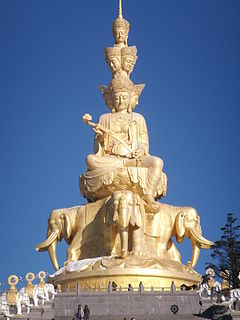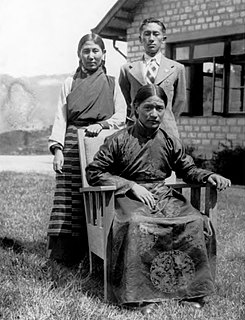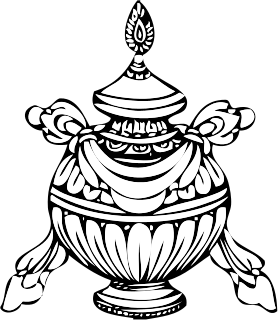Related Research Articles

Samantabhadra is a bodhisattva in Buddhism associated with practice and meditation. Together with Gautama Buddha and the bodhisattva Mañjuśrī, he forms the Shakyamuni Triad in Mahayana Buddhism. He is the patron of the Lotus Sutra and, according to the Avatamsaka Sutra, made the ten great vows which are the basis of a bodhisattva. In Chinese Buddhism, Samantabhadra is known as Pǔxián and is associated with action, whereas Mañjuśrī is associated with prajñā. In Japan, this bodhisattva is known as Fugen, and is often venerated in Tendai and Shingon Buddhism, and as the protector of the Lotus Sutra by Nichiren Buddhism. In Sri lanka, he is known as Sumana Samana Deviyo and is regarded as the guardian of the island of Sri Lanka.

The Nyingma school is the oldest of the four major schools of Tibetan Buddhism, founded by Vajrayana revealer Guru Padmasambhava. "Nyingma" literally means "ancient," and is often referred to as Ngangyur, "school of the ancient translations" or "old school". The Nyingma school is founded on the first translations of Buddhist scriptures from Sanskrit into Old Tibetan in the eighth century, during the reign of King Trisong Detsen. The Tibetan alphabet was created for this endeavour, and the classical variety of the Tibetan language standardised.

Jamyang Khyentse Wangpo, also known by his tertön title, Pema Ösel Dongak Lingpa, was a renowned teacher, scholar and tertön of 19th-century Tibet. He was a leading figure in the Rimé movement.

Jigme Lingpa (1730–1798) was a Tibetan tertön of the Nyingma lineage of Tibetan Buddhism. He was the promulgator of the Longchen Nyingthig, the Heart Essence teachings of Longchenpa, from whom, according to tradition, he received a vision in which the teachings were revealed. The Longchen Nyingthik eventually became the most famous and widely practiced cycle of Dzogchen teachings.
Shechen Monastery is one of the "Six Mother Monasteries" of the Nyingma tradition of Tibetan Buddhism. It was originally located in Kham, Tibet, but was destroyed in the late 1950s during the Cultural Revolution and was rebuilt in Nepal in 1985.

Kyabje Dudjom Jigdral Yeshe Dorje known as Terchen Drodül Lingpa and as Dudjom Rinpoche, is considered by Tibetan Buddhists to be from an important Tulku lineage, a renowned Tertön treasure revealer and a direct incarnation of Padmasambhava and of Dudjom Lingpa (1835–1904). He is a Nyingma householder, yogi, and a Vajrayana and Dzogchen master, and according to disciple Khenpo Tsewang Dongyal is referred to by them as "His Holiness" and as a "master of masters".
Anuyoga is the designation of the second of the three Inner Tantras according to the ninefold division of practice used by the Nyingma school of Tibetan Buddhism. As with the other yanas, Anuyoga represents both a scriptural division as well as a specific emphasis of both view and practice.
The Five Pure Lights is an essential teaching in the Dzogchen tradition of Bon and Tibetan Buddhism. For the deluded, matter seems to appear. This is due to non-recognition of the five lights. Matter includes the mahābhūta or classical elements, namely: space, air, water, fire, earth. Knowledge (rigpa) is the absence of delusion regarding the display of the five lights. This level of realization is called rainbow body.

Kyichu Lhakhang, is an important Himalayan Buddhist temple situated in Lango Gewog of Paro District in Bhutan.
Rongzom Chökyi Zangpo, widely known as Rongzom Mahapandita, Rongzom Dharmabhadra, or simply as Rongzompa, was one of the most important scholars of the Nyingma school of Tibetan Buddhism. Together with Longchenpa and Ju Mipham, he is often considered to be one of the three "omniscient" writers of the school. His elder contemporary Atiśa (980–1054) considered Rongzompa to be an incarnation of the Indian ācārya Kṛṣṇapāda, the Great. The Tibetan historian Gö Lotsawa (1392–1481) said of Rongzom that no scholar in Tibet was his equal.
Lawapa or Lavapa was a figure in Tibetan Buddhism who flourished in the 10th century. He was also known as Kambala and Kambalapada. Lawapa, was a mahasiddha, or accomplished yogi, who travelled to Tsari. Lawapa was a progenitor of the Dream Yoga sādhanā and it was from Lawapa that the mahasiddha Tilopa received the Dream Yoga practice lineage.
Tibetan astrology is a traditional discipline of the Tibetan peoples that has dialogued with both Chinese astrology and Indian astrology. Tibetan astrology is one of the 'Ten Sciences' in the enumeration honoured by this cultural tradition.
Indrabhuti is a name attributed to a number of individuals that have become conflated in Vajrayana Buddhism. One Indrabhuti, considered a Mahasiddha, was a disciple of Lawapa.
Getse Mahapandita (1761–1829) was an important Nyingma scholar affiliated with Kathok Monastery.
sNub-Ben Namkha'i Nyingpo is counted amongst the principal "twenty-five disciples" of Padmasambhava. sNub Ben Namkha'i Nyingpo was a realized practitioner of Śāntarakṣita’s tradition of Sutrayana "gradualist" Mahayana Buddhism as well as simultaneously being one of the most accomplished Tibetan practitioners of the East Mountain Teaching of Chan Buddhism, which transmits the "subitist" tradition of Mahayana Buddhism.

Ma Rinchen Chok, is numbered as one of the twenty-five principal disciples of Padmasambhava. Rinchen Chok was also a senior disciple of Vimalamitra. Rinchen Chok was an important lotsawa in the first wave of translations and was one of the first seven monks ever to be ordained in Tibet by Shantarakshita, known as the 'seven men who were tested'. The ordination lineage was Sarvastivadin.

The Sheja Dzö or "Treasury of Knowledge" is a voluminous work by Jamgon Kongtrul (1813–1899). It is constituted by a root text in verse "The Encompassment of All Knowledge" and an autocommentary in prose, 'The Infinite Ocean of Knowledge'. The Treasury of Knowledge is widely considered Jamgon Kongtrul's masterpiece, covering the full spectrum of Buddhist history according to the knowledge then current in the Himalayas; the Abhidharma through the lens of Vasubandhu ; the Buddhist philosophy preserved, categorized and developed in the Himalayas; and the many streams of Buddhist sādhanā both exoteric (sutrayana) and esoteric (vajrayana), transmitted to, maintained and developed by the many trans-Himalayan lineages, such as Mahamudra and Dzogchen. The breadth of the Sheja Dzö is encyclopedic and its approach ecumenical. The root text in verse is terse and ostensibly glib approaching telegraphic. Whereas, the tone and register of the commentary is non-sectarian in regards to the many systems of Buddhadharma it enshrines. The Sheja Dzö is the central reference and general auspice work in Rimé movement literature.
In the Dzogchen tradition in Tibetan Buddhism ground is the primordial state. It is an essential component of the Dzogchen tradition for both the Bonpo and the Nyingmapa. Knowledge of this Ground is called rigpa.
Gyurme Dorje was a Scottish Tibetologist and writer.
In the Nyingma Tibetan Buddhist Dharma teachings faith's essence is to make one's being, and perfect dharma, inseparable. The etymology is the aspiration to achieve one's goal. Faith's virtues are like a fertile field, a wishing gem, a king who enforces the law, someone who holds the carefulness stronghold, a boat on a great river and an escort in a dangerous place. Faith in karma causes temporary happiness in the higher realms. Faith is a mental state in the Abhidharma literature's fifty-one mental states. Perfect faith in the Buddha, his Teaching (Dharma) and the Order of his Disciples (Sangha) is comprehending these three jewels of refuge with serene joy based on conviction. The Tibetan word for faith is day-pa, which might be closer in meaning to confidence, or trust.
References
- Getty, Alice. Gaņeśa: A Monograph on the Elephant-Faced God. (Clarendon Press: Oxford, 1936). 1992 reprint edition, ISBN 81-215-0377-X . Individual chapters are devoted to individual countries and regions of the world.